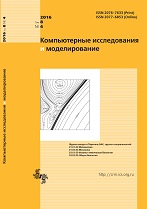|
This article is cited in 3 scientific papers (total in 3 papers)
SOLVING INDUSTRIAL PROBLEMS IN FLOWVISION SOFTWARE
Verification of calculated characteristics of supersonic turbulent jets
J. V. Fisher, A. E. Shchelyaev
Ltd. «TESIS»,
of. 701, 18 Yunnatov st., Moscow, 125083, Russia
Abstract:
Verification results of supersonic turbulent jets computational characteristics are presented. Numerical simulation of axisymmetric nozzle operating is realized using FlowVision CFD. Open test cases for CFD are used. The test cases include Seiner tests with exit Mach number of $2.0$ both fully-expanded and under-expanded ($P/P0=1.47$). Fully-expanded nozzle investigated with wide range of flow temperature ($300\dots3000$ K). The considered studies include simulation downstream from the nozzle exit diameter. Next numerical investigation is presented at an exit Mach number of $2.02$ and a free-stream Mach number of $2.2$. Geometric model of convergent-divergent nozzle rebuilt from original Putnam experiment. This study is set with nozzle pressure ratio of $8.12$ and total temperature of $317$ K.
The paper provides a comparison of obtained FlowVision results with experimental data and another current CFD studies. A comparison of the calculated characteristics and experimental data indicates a good agreement. The best coincidence with Seiner's experimental velocity distribution (about $7$ % at far field for the first case) obtained using two-equation $k-\epsilon$ standard turbulence model with Wilcox compressibility correction. Predicted Mach number distribution at $Y/D=1$ for Putnam nozzle presents accuracy of $3$ %.
General guidelines for simulation of supersonic turbulent jets in the FlowVision software are formulated in the given paper. Grid convergence determined the optimal cell rate. In order to calculate the design regime, it is recommended to build a grid, containing not less than $40$ cells from the axis of symmetry to the nozzle wall. In order to calculate an off-design regime, it is necessary to resolve the shock waves. For this purpose, not less than $80$ cells is required in the radial direction. Investigation of the influence of turbulence model on the flow characteristics has shown that the version of the SST $k-\omega$ turbulence model implemented in the FlowVision software essentially underpredicts the axial velocity. The standard $k-\epsilon$ model without compressibility correction also underpredicts the axial velocity. These calculations agree well with calculations in other CFD codes using the standard $k-\epsilon$ model. The in-home $k-\epsilon$ turbulence model KEFV with compressibility correction a little bit overpredicts the axial velocity. Since, the best results are obtained using the standard $k-\epsilon$ model combined with the Wilcox compressibility correction, this model is recommended for the problems discussed.
The developed methodology can be regarded as a basis for numerical investigations of more complex nozzle flows.
Keywords:
computational fluid dynamics, turbulence jets, supersonic nozzle flow.
Received: 01.11.2016
Revised: 21.12.2016
Accepted: 30.12.2016
Citation:
J. V. Fisher, A. E. Shchelyaev, “Verification of calculated characteristics of supersonic turbulent jets”, Computer Research and Modeling, 9:1 (2017), 21–35
Linking options:
https://www.mathnet.ru/eng/crm43 https://www.mathnet.ru/eng/crm/v9/i1/p21
|

| Statistics & downloads: |
| Abstract page: | 196 | | Full-text PDF : | 74 | | References: | 27 |
|




 Contact us:
Contact us: Terms of Use
Terms of Use
 Registration to the website
Registration to the website Logotypes
Logotypes








 Citation in format
Citation in format 
